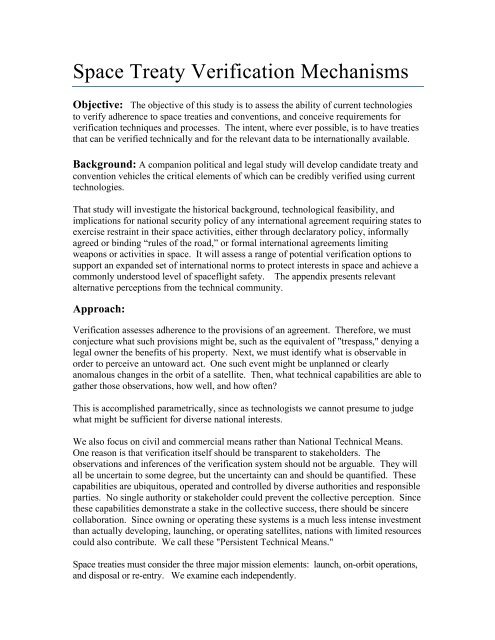Space and Verification
Space and Verification
Space and Verification
You also want an ePaper? Increase the reach of your titles
YUMPU automatically turns print PDFs into web optimized ePapers that Google loves.
<strong>Space</strong> Treaty <strong>Verification</strong> Mechanisms<br />
Objective: The objective of this study is to assess the ability of current technologies<br />
to verify adherence to space treaties <strong>and</strong> conventions, <strong>and</strong> conceive requirements for<br />
verification techniques <strong>and</strong> processes. The intent, where ever possible, is to have treaties<br />
that can be verified technically <strong>and</strong> for the relevant data to be internationally available.<br />
Background: A companion political <strong>and</strong> legal study will develop c<strong>and</strong>idate treaty <strong>and</strong><br />
convention vehicles the critical elements of which can be credibly verified using current<br />
technologies.<br />
That study will investigate the historical background, technological feasibility, <strong>and</strong><br />
implications for national security policy of any international agreement requiring states to<br />
exercise restraint in their space activities, either through declaratory policy, informally<br />
agreed or binding “rules of the road,” or formal international agreements limiting<br />
weapons or activities in space. It will assess a range of potential verification options to<br />
support an exp<strong>and</strong>ed set of international norms to protect interests in space <strong>and</strong> achieve a<br />
commonly understood level of spaceflight safety. The appendix presents relevant<br />
alternative perceptions from the technical community.<br />
Approach:<br />
<strong>Verification</strong> assesses adherence to the provisions of an agreement. Therefore, we must<br />
conjecture what such provisions might be, such as the equivalent of "trespass," denying a<br />
legal owner the benefits of his property. Next, we must identify what is observable in<br />
order to perceive an untoward act. One such event might be unplanned or clearly<br />
anomalous changes in the orbit of a satellite. Then, what technical capabilities are able to<br />
gather those observations, how well, <strong>and</strong> how often?<br />
This is accomplished parametrically, since as technologists we cannot presume to judge<br />
what might be sufficient for diverse national interests.<br />
We also focus on civil <strong>and</strong> commercial means rather than National Technical Means.<br />
One reason is that verification itself should be transparent to stakeholders. The<br />
observations <strong>and</strong> inferences of the verification system should not be arguable. They will<br />
all be uncertain to some degree, but the uncertainty can <strong>and</strong> should be quantified. These<br />
capabilities are ubiquitous, operated <strong>and</strong> controlled by diverse authorities <strong>and</strong> responsible<br />
parties. No single authority or stakeholder could prevent the collective perception. Since<br />
these capabilities demonstrate a stake in the collective success, there should be sincere<br />
collaboration. Since owning or operating these systems is a much less intense investment<br />
than actually developing, launching, or operating satellites, nations with limited resources<br />
could also contribute. We call these "Persistent Technical Means."<br />
<strong>Space</strong> treaties must consider the three major mission elements: launch, on-orbit operations,<br />
<strong>and</strong> disposal or re-entry. We examine each independently.
















